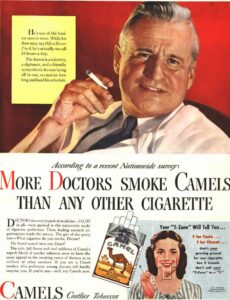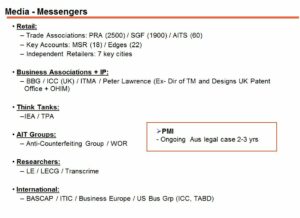Third Party Techniques
This page was last edited on at
Background – What is the Third Party Technique?
The third party technique has been called the “heart of public relations” and has been used for decades by the public relations (PR) industry. For example, in 1991, Merrill Rose, the Executive Vice President of the PR firm Porter/Novelli, advised companies about the technique, which can offer controversial actors a credible voice:
“Put your words in someone else’s mouth … There will be times when the position you advocate, no matter how well framed and supported, will not be accepted by the public simply because you are who you are. Any institution with a vested commercial interest in the outcome of an issue has a natural credibility barrier to overcome with the public, and often, with the media.”1
Four years later, in 1995, Amanda Little, Manager of Communications Services from the Sydney office of PR firm Burson-Marsteller, told an advertising conference:2
“For the media and the public, the corporation will be one of the least credible sources of information, on its own product, environmental and safety risks. Both these audiences will turn to other experts … to get an objective viewpoint.”
“Developing third party support and validation for the basic risk messages of the corporation is essential. This support should ideally come from medical authorities, political leaders, union officials, relevant academics, fire and police officials, environmentalists, regulators.”
Historic Tobacco Industry Use of the Third Party

Given the controversial nature of its product, it is not surprising that the tobacco industry has used this tactic for decades whereby pro-smoking and anti-tobacco control arguments are made by seemingly independent third-parties. These include Think Tanks, Front Groups, Lobby Groups, Astroturfing organisations and many other allies.
Over the years, the industry has used doctors (image 1); supposedly independent academics and researchers, as well as financial analysts “to support the industry’s political and public policy agenda.3 4 5
For more information on the third party technique utilised by the tobacco industry, see:
- Influencing Science
- TPD: Creating Doubt About Scientific Evidence the example of Imperial in Canada
- TPD: Commissioning Research and Reviews
- TPD: Ghost Writing
- TPD: Funding Scientists, academic centres and journals
The tobacco archives also contain numerous documents revealing how celebrities have been used by the industry, including to:
- Promote “smoking and tolerance;” 6
- To advertise cigarettes; 7
- “To smoke KOOL cigarettes in movies;” 8
- To take part in industry-sponsored sporting events with “excellent TV possibilities.” 9
Point of Sale Display Ban, Plain Packaging & the EU Tobacco Products Directive
The tobacco industry has extensively used third parties to lobby against the proposed Point of Sale Ban in the UK; plain packaging in Australia and the UK as well as the EU Tobacco Products Directive Revision.
A series of leaked documents from Philip Morris International (PMI) on their use of third parties to fight both Point of Sale and plain packaging is illuminating.
PMI’s media plan for plain packaging (image 2) outlined six main types of 3rd party “messengers”, including:
- Retail groups;
- Business associations;
- Think tanks;
- Anti-counterfeiting groups;
- Researchers;
- International organisations.
Part of the strategy was to build alliances with natural allies of the industry; such as other business organisations, but also to use think tanks such as the Institute of Economic Affairs, in the press, even though the tobacco funding link was often unreported. It has also included employing ex-Policemen, such as Will O’Reilly to scaremonger about illicit tobacco in order to try and prevent plain packaging.

For more see:
- PMI’s Anti-PP Media Campaign
- PMI’s Anti-Plain Packaging Lobbying Campaign
- PMI’s “Illicit Trade” Anti-Plain Packaging Campaign
- PMI’s Lobbying Campaign to Undermine the TPD
- PMI Mobilised Support from Retailers
- Alliance of Australian Retailers
- Chris Argent
- Philip Morris’ PR Campaign Against the Display Ban
- Philip Morris’ Regulatory Litigation Action Plan Against the Display Ban
- TPD: Delaying the Process of Consultation
- Will O’Reilly
TobaccoTactics Resources
- A comprehensive list of Think Tanks from around the world associated with the tobacco industry
- A selection of Lobby Groups including trade associations from around the world associated with the tobacco industry
- Front Groups
- Astroturfing
Also:
- See the list of all pages in the category Third Party Techniques
- Read more about Tobacco Industry Tactics